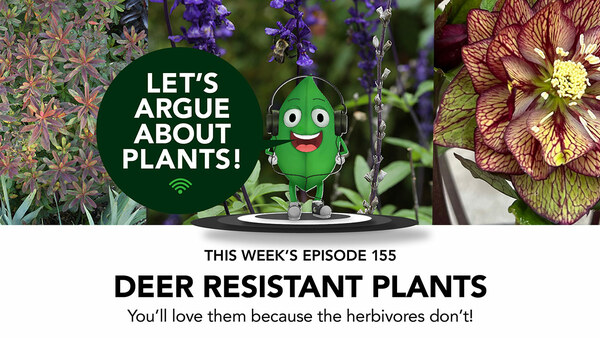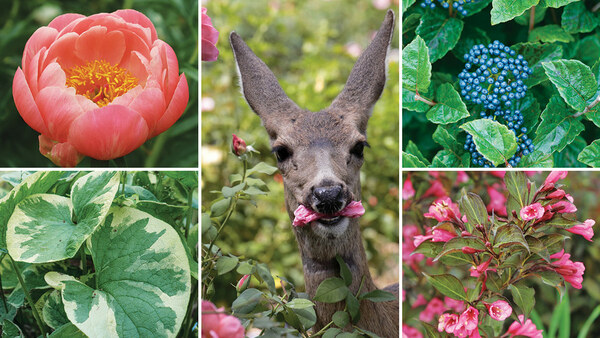
Creating a garden with a backbone of colorful, interesting foliage ensures interest even when nothing is in bloom or if inquisitive deer decide to taste-test the flower buds. Varying the texture and height of plants also disguises any indiscriminate munching that would be very obvious in a monoculture. This garden exhibits those principles while also utilizing a selection of deer-resistant plants to keep the space looking good year-round despite pest pressure. Here are some of the key plants that tie this design together.
1. Wine & Roses® weigela
Name: Weigela florida ‘Alexandra’
Zones: 4–8
Size: 4 to 5 feet tall and wide
Conditions: Full sun to partial shade; well-drained soil
Native range: Korea, Japan, northern China
This shrub is perfect for the back of the border, offering height, screening, colorful foliage, vibrant flowers, and reliable deer resistance.
To learn more about Wine & Roses® weigela, and discover more deer-resistant plants to replace common deer favorites, check out 32 Plants for Sun and Shade That the Deer Won’t Devour
2. Lady’s mantle
Name: Alchemilla mollis
Zones: 3–8
Size: 1 to 1½ feet tall and 1½ to 2 feet wide
Conditions: Partial shade; moist, well-drained soil
Native range: Eastern Europe
Lady’s mantle has seduced many a gardener with its froth of diminutive chartreuse flowers and softly pleated leaves. It’s a fabulous addition to the cut-flower garden as well as ornamental borders. This perennial is not for the faint of heart, however, as it self-seeds with abandon and may need regular thinning out.
3. ‘Palace Purple’ heuchera
Name: Heuchera ‘Palace Purple’
Zones: 4–9
Size: 1 to 2 feet tall and wide
Conditions: Full sun to partial shade; well-drained soil
Native range: Hybrid
It’s not the latest or greatest, but this heuchera may well be the toughest of them all. ‘Palace Purple’ has large, shiny, bronze-purple leaves and tall creamy-white flower scapes. Although rabbits and deer often favor heuchera, this selection will excite them less than most.
4. ‘Caesar’s Brother’ Siberian iris
Name: Iris sibirica ‘Caesar’s Brother’
Zones: 4–9
Size: 3 to 3½ feet tall and 1½ to 2 feet wide
Conditions: Full sun to partial shade; moist soil
Native range: Northeastern Europe, central Asia
The strap-like foliage of ‘Caesar’s Brother’ Siberian iris provides valuable texture, while the classic blue flowers bloom well in both full sun and partial shade. Unlike bearded iris, Siberian iris prefers moisture-retentive soil and even tolerates wet conditions.
5. Giant allium
Name: Allium giganteum
Zones: 5–8
Size: 3 to 5 feet tall and 1½ to 2 feet wide
Conditions: Full sun to partial shade; medium to dry, well-drained soil
Native range: Central and southwestern Asia
Rising to 5 feet tall with spherical blooms the size of softballs, this ornamental onion makes a statement in early summer. Because of their stature the stems may need staking, so planting them in an area with protection from strong winds is advised.
6. ‘Victoria’ weigela
Name: Weigela ‘Victoria’
Zones: 4–8
Size: 4 to 6 feet tall and wide
Conditions: Full sun to partial shade; well-drained soil
Native range: Hybrid
‘Victoria’ is a compact variety of weigela that features dark foliage and hot-pink tubular flowers hummingbirds enjoy. Like all weigelas, it adapts to a variety of soil types and thrives in full sun.
7. ‘Husker Red’ penstemon
Name: Penstemon digitalis ‘Husker Red’
Zones: 3–8
Size: 2 to 3 feet tall and 1 to 2 feet wide
Conditions: Full sun; medium to dry, well-drained soil
Native range: Eastern North America
Even without flowers, this penstemon would be worthy of inclusion in the garden for its drought tolerance, deer resistance, and richly colored leaves. Yet the tall spires of white, tubular flowers that bloom in spring are a bonus appreciated by hummingbirds and bees.
8. Bearded iris
Name: Iris cv.
Zones: 3–9
Size: 2 to 4 feet tall and 2 feet wide
Conditions: Full sun; well-drained soil
Native range: Central and southern Europe
Thriving in full sun, bearded irises offer bold foliage that contrasts with the elliptical leaf forms of many shrubs and perennials. The flowers come in a wide array of colors, including multihued ones. The yellow blooms in this planting add a stunning pop of color. Plant the rhizomes with the “knuckles” showing; planting too deep can cause rot and reduce flower production.
Karen Chapman is a landscape designer in Duvall, Washington, and the author of Deer-Resistant Design: Fence-Free Gardens That Thrive Despite the Deer.
Fine Gardening Recommended Products

XLUX Soil Moisture Meter

Dramm 17050 50′ ColorStorm 1/2″ Standard Soaker Hose

Rain Bird PATIOKIT Drip Irrigation Patio Watering Kit

Morvat Heavy Duty Brass Y-Valve

Water Right PSH-100-MG-1PKRS 400 Series, 100-Foot, Olive Green

















Comments
Log in or create an account to post a comment.
Sign up Log in